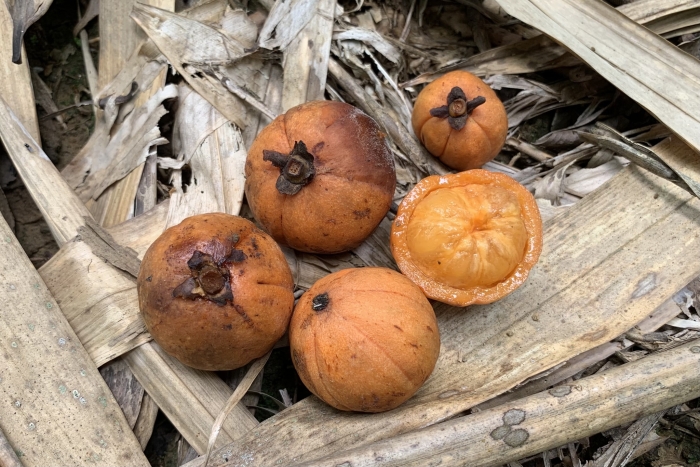Cowa Mangosteen
(Garcinia cowa)
Cowa Mangosteen (Garcinia cowa)
/
/

© Apichart Songsangchun
CC BY 4.0
Image By:
© Apichart Songsangchun
Recorded By:
Copyright:
CC BY 4.0
Copyright Notice:
Photo by: © Apichart Songsangchun | License Type: CC BY 4.0 | License URL: http://creativecommons.org/licenses/by/4.0/ | Uploader: apichart_songsangchun | Publisher: iNaturalist |












Estimated Native Range
Summary
Garcinia cowa, commonly known as Cowa Mangosteen, is an evergreen tree native to the tropical rainforests of Southeast Asia, particularly in countries like India, Thailand, and Malaysia. This species typically grows to a height of 15-25 feet (4.5-7.6 meters) with a similar spread. The tree features a dense canopy with glossy, dark green leaves and produces small, yellow flowers that are not particularly showy. The flowering season occurs sporadically throughout the year in its native climate. The fruits are round, with a thick rind and acidic flavor, resembling a small mangosteen.
Cowa Mangosteen is valued for its edible fruit, which is used in a variety of culinary applications, including curries and pickles, and as a souring agent similar to tamarind. The bark, which contains tannins, is traditionally used for dyeing fabric. In terms of cultivation, Garcinia cowa prefers humid, tropical conditions with well-drained, fertile soils and partial to full sun exposure. It is relatively low-maintenance once established but may require regular watering during dry periods. The plant is also known for its various medicinal properties in traditional medicine, including anti-inflammatory and antimicrobial effects. However, it is not commonly grown outside its native range and can be susceptible to pests like fruit flies and diseases such as root rot if conditions are not ideal.CC BY-SA 4.0
Cowa Mangosteen is valued for its edible fruit, which is used in a variety of culinary applications, including curries and pickles, and as a souring agent similar to tamarind. The bark, which contains tannins, is traditionally used for dyeing fabric. In terms of cultivation, Garcinia cowa prefers humid, tropical conditions with well-drained, fertile soils and partial to full sun exposure. It is relatively low-maintenance once established but may require regular watering during dry periods. The plant is also known for its various medicinal properties in traditional medicine, including anti-inflammatory and antimicrobial effects. However, it is not commonly grown outside its native range and can be susceptible to pests like fruit flies and diseases such as root rot if conditions are not ideal.CC BY-SA 4.0
Plant Description
- Plant Type: Tree
- Height: 10-20 feet
- Width: 10-15 feet
- Growth Rate: Moderate
- Flower Color: N/A
- Flowering Season: Spring
- Leaf Retention: Evergreen
Growth Requirements
- Sun: Full Sun
- Water: Medium
- Drainage: Medium
Common Uses
Edible*Disclaimer: Easyscape's listed plant edibility is for informational use. Always verify the safety and proper identification of any plant before consumption., Low Maintenance, Potted Plant
Natural Habitat
Tropical rainforests of Southeast Asia
Other Names
Common Names: Cow’s Milk Garcinia, Cow’s Milk Fruit
Scientific Names: , Garcinia cowa, Cambogia crassifolia, Garcinia cambogia, Garcinia cornea, Garcinia cornea, Garcinia cowa, Garcinia dioica, Garcinia lobulosa, Garcinia roxburghii
GBIF Accepted Name: